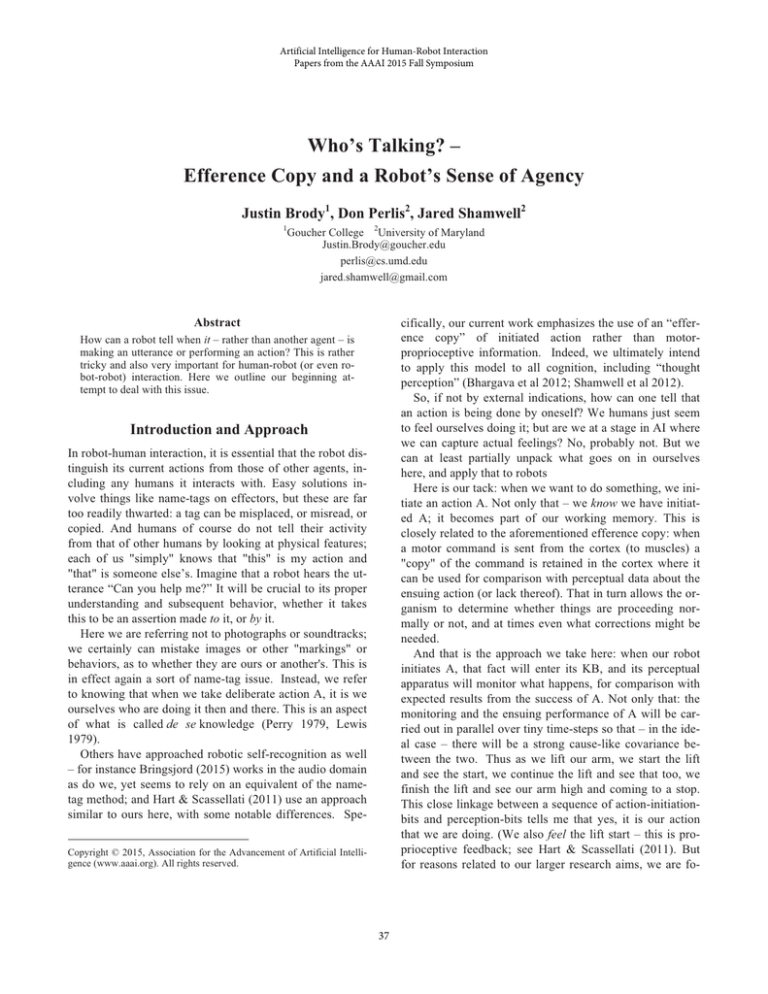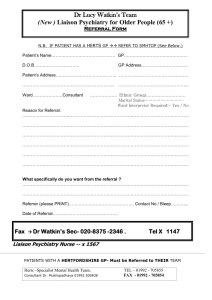
Artificial Intelligence for Human-Robot Interaction
Papers from the AAAI 2015 Fall Symposium
Who’s Talking? –
Efference Copy and a Robot’s Sense of Agency
Justin Brody1, Don Perlis2, Jared Shamwell2
1
Goucher College 2University of Maryland
Justin.Brody@goucher.edu
perlis@cs.umd.edu
jared.shamwell@gmail.com
cifically, our current work emphasizes the use of an “efference copy” of initiated action rather than motorproprioceptive information. Indeed, we ultimately intend
to apply this model to all cognition, including “thought
perception” (Bhargava et al 2012; Shamwell et al 2012).
So, if not by external indications, how can one tell that
an action is being done by oneself? We humans just seem
to feel ourselves doing it; but are we at a stage in AI where
we can capture actual feelings? No, probably not. But we
can at least partially unpack what goes on in ourselves
here, and apply that to robots
Here is our tack: when we want to do something, we initiate an action A. Not only that – we know we have initiated A; it becomes part of our working memory. This is
closely related to the aforementioned efference copy: when
a motor command is sent from the cortex (to muscles) a
"copy" of the command is retained in the cortex where it
can be used for comparison with perceptual data about the
ensuing action (or lack thereof). That in turn allows the organism to determine whether things are proceeding normally or not, and at times even what corrections might be
needed.
And that is the approach we take here: when our robot
initiates A, that fact will enter its KB, and its perceptual
apparatus will monitor what happens, for comparison with
expected results from the success of A. Not only that: the
monitoring and the ensuing performance of A will be carried out in parallel over tiny time-steps so that – in the ideal case – there will be a strong cause-like covariance between the two. Thus as we lift our arm, we start the lift
and see the start, we continue the lift and see that too, we
finish the lift and see our arm high and coming to a stop.
This close linkage between a sequence of action-initiationbits and perception-bits tells me that yes, it is our action
that we are doing. (We also feel the lift start – this is proprioceptive feedback; see Hart & Scassellati (2011). But
for reasons related to our larger research aims, we are fo-
Abstract
How can a robot tell when it – rather than another agent – is
making an utterance or performing an action? This is rather
tricky and also very important for human-robot (or even robot-robot) interaction. Here we outline our beginning attempt to deal with this issue.
Introduction and Approach
In robot-human interaction, it is essential that the robot distinguish its current actions from those of other agents, including any humans it interacts with. Easy solutions involve things like name-tags on effectors, but these are far
too readily thwarted: a tag can be misplaced, or misread, or
copied. And humans of course do not tell their activity
from that of other humans by looking at physical features;
each of us "simply" knows that "this" is my action and
"that" is someone else’s. Imagine that a robot hears the utterance “Can you help me?” It will be crucial to its proper
understanding and subsequent behavior, whether it takes
this to be an assertion made to it, or by it.
Here we are referring not to photographs or soundtracks;
we certainly can mistake images or other "markings" or
behaviors, as to whether they are ours or another's. This is
in effect again a sort of name-tag issue. Instead, we refer
to knowing that when we take deliberate action A, it is we
ourselves who are doing it then and there. This is an aspect
of what is called de se knowledge (Perry 1979, Lewis
1979).
Others have approached robotic self-recognition as well
– for instance Bringsjord (2015) works in the audio domain
as do we, yet seems to rely on an equivalent of the nametag method; and Hart & Scassellati (2011) use an approach
similar to ours here, with some notable differences. SpeCopyright © 2015, Association for the Advancement of Artificial Intelligence (www.aaai.org). All rights reserved.
37
the closeness of match in real time and thus infer that it is
hearing its own output. But because of noise, the match
will be far from perfect. Thus the question is whether a
suitable comparison method can separate “good-enough”
matches from poor ones.
For this purpose, we had Festival generate WAV-out
files for four sentences, and then created four WAV-in files
from the four resulting microphone signals. A simple
sound-frame-based comparison was done, employing the
following utterances:
1. Hello, human. I’m very pleased to meet you.
2. Hello, human. I’m very cheesed to meet you.
3. Hello, Hugh. I meet you.
4. This is entirely different.
The idea is that Alice utters 1 (WAV-out_1), and may hear
noisy versions of any of 1-4 (WAV_in_1, i=1…4). We
then compared WAV-out_1 (our efference copy) with each
of WAV-in_i. As it turned out, neither WAV-in_1 nor
WAV-in_2 was a truly good match for WAV-out_1. But
this is not surprising given the noise inherent in any recording method. We did find that despite this poor match, it
was still significantly better than the matches of WAVin_3 and WAV-in_4 to WAV-out_1. Thus if the robot utters 1 above, while hearing 3 or 4, it can tell that this is not
what it is producing, whereas hearing 1 or 2 can pass muster, using the sound-comparison formula we worked with;
in fact, 2 scored higher than 1; and 3 and 4 were almost
identical in (low) score. Research shows we often do not
utter what we think we are saying, nor hear what others are
uttering: we infer expected sounds a great deal (McGurk
1976. Niziolec 2013, Pinker 1994). Yet as long as the pattern of stresses has a close temporal similarity in output
and input, it is not reasonable to suppose that one is hearing one’s own immediate (albeit distorted) speech.
cused primarily on the efference-copy approach, which also seems to bear more immediately on auditory decision
processes.)
Our approach can also be viewed through the lens of Gallagher’s notions of a “sense of ownership” and “sense of
agency” (Gallagher 2000). Our agent is training to recognize its own voice and the control it has over it. These can
be considered crucial elements in the development of selfawareness (which is our broader program; see Brody et al
(2012) and reasoning about other agents.
Of course one can tell a story where in fact we are not
doing the lifting at all – our arm is numb and a hidden
string is lifting the arm just as we are sending the (ineffective) lifting signals. So we can be fooled (at least about
physical actions); and our robots need not be better than we
at this.
Example and Some Technical Details
Here is an example, that arose in our own work: One of our
Baxter robots (named Alice) had been programmed to look
for – and then point to – another Baxter (Julia) while saying "I see Julia and I am pointing at her", whenever hearing
an utterance containing the word "Julia". But we found,
most oddly, that in some cases Alice performed as expected, and then a few seconds later spoke and pointed
again, and then again, on and on. Finally we realized that
Alice was hearing her own utterance which contained the
key word, “Julia” which triggered her repeat actions.
So our solution is this: Alice should be made aware of
her own action-initiation efforts via efference copy, including speech acts, so that she can tell when she is hearing an
ongoing uttereance that matches her own current effort;
from this she can infer that it is not a command from us.
But if she hears "Julia" and is not uttering it herself then
she fairly infers that another agent is doing so, and she then
should respond accordingly. Note that is not enough for
Alice merely to remember making some particular utterance; for we might make the same utterance later on, and
Alice should not regard it as hers but rather as another instance of it uttered by us, which she then should consider
for possible response. That is, she should know – in the
language of her KB – whether it is I (herself) or Another
(e.g., us) who is performing an action right now.
The figure above shows WAV-out (top) compared to
WAV-in_1 (left) and to WAV-in_3 (right). Even though
the mic has in theory picked up the same signal as was sent
to the speaker (on the left) distortions made significant
changes; but mathematical massaging was still able to classify WAV-in_1 (and also case 2) as close to WAV-out,
compared to cases 3 (right) and 4, which were significantly
further away.
Alice’s speech is generated by the Festival Speech Synthesis System (http://www.cstr.ed.ac.uk/projects/festival/).
The issue we explored was this: If an utterance is produced
on the speaker from an “efference” file WAV-out (such as
might in humans go to speech-producing muscles), and a
microphone simultaneously picks up that sound signal
which then is used to create a file WAV-in, then WAV-out
and WAV-in should be close enough that a robot can track
Our long-range plans include massive use of efference
copy, not only in regard to speech but also other physical
38
actions and even to the robotic agent’s own internal “thinking” actions (Bhargava et al 2012).
Acknowledgments
We thank Carol Espy-Wilson for much-needed advice on
processing sound and speech, and ONR for grant support.
References
Bhargava, P., Cox, M., Oates, T., Uran, O., Paisner, M., Perlis,
D., and Shamwell. J. 2012. The robot baby and massive metacognition: Future vision. Proceedings of IEEE International Conference on Development, Learning, and Epigetic Robotics.
Bringsjord, S., et al. 2015. Real robots that pass human tests of
self-consciousness. In Proceedings of IEEE the 24th International
Symposium on Robots and Human Interactive Communications.
Brody, J,. Cox, M., and Perlis, D. 2013. The processual self as
cognitive unifier. Proceedings of IACAP 2013.
Gallagher, S. 2000. Philosophical conceptions of the self: implications for cognitive science. Trends in Cognitive Science (4):
14-21
Hart, J., and Scassellati, B. 2011. Robotic models of self. In: Cox
and Raja, eds, Metareasoning: Thinking About Thinking. Cambridge, MA, MIT Press.
Lewis, D. 1979. Attitudes De Dicto and De Se. The Philosophical Review: 88(4): 513-543
McGurk, H, and MacDonald, J. 1976. Hearing lips and seeing
voices. Nature: 264(5588): 746-8.
Niziolec, C., Nagarajan, S., and Houde, J. 2013. What does motor
efference copy represent? Evidence from speech production. The
Journal of Neuroscience 33(41): 16110-16116.
Perry, J. 1979. The problem of the essential indexical. Nous
13(1): 3-21.
Pinker, S. 1994. The Language Instinct. William Morrow.
Shamwell, J., Oates, T., Bhargava, P., Cox, M., Oh, U., Paisner,
M., and Perlis, D. 2012. The robot baby and massive metacognition: Early steps via growing neural gas. Proceedings of IEEE International Conference on Development, Learning, and Epigetic
Robotics.
39





